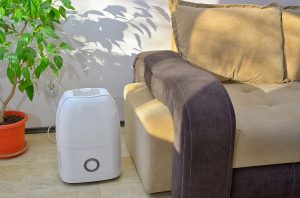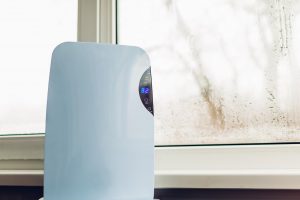Looking for the right dehumidifier size is one of the most crucial things that one must consider before buying one.
A dehumidifier helps remove moisture from the air, thus stopping the growth of dust mites, moulds, and other microorganisms that thrive in a moist environment.
For a dehumidifier to stay effective, the right size is essential as it dramatically affects water extraction. Here is a quick guide in helping you determine the right type and size needed for your home for those looking to buy a dehumidifier. We have also compiled a list of our choice of the top dehumidifiers to buy.
Contents
- 1 Key Takeaways
- 2 What Is Dehumidifier Size?
- 3 How Do You Choose a Size?
- 4 What Sizes Are Available?
- 5 What Size Dehumidifier Do I Need for a Garage?
- 6 What Size Dehumidifier Do I Need for a 2 Bedroom House?
- 7 What Size Dehumidifier Do I Need for a 3 Bedroom House?
- 8 Do I Need a Dehumidifier in Every Room?
- 9 Do Dehumidifiers Increase Your Electric Bill?
- 10 Heat Pump Source: Reliable Heating and Cooling Solutions
- 11 Conclusion
Key Takeaways
- Dehumidifier size is crucial and refers to its capacity to remove moisture from the air over 24 hours, impacting its effectiveness.
- When choosing the right dehumidifier size, consider factors like relative humidity rates, room temperature, and square footage, ensuring it matches your needs.
- While larger dehumidifiers can cover more significant areas, finding the right balance is essential to avoid excessive electricity consumption and ensure optimal performance.
What Is Dehumidifier Size?
Dehumidifier size doesn’t describe the physical size of the dehumidifier itself but its capacity to cover room areas. This means that this is the amount of water that the machine can hold and extract in a day.
 In most cases, models with larger water capacity may sometimes appear bigger, but this shouldn’t be the basis at all size.
In most cases, models with larger water capacity may sometimes appear bigger, but this shouldn’t be the basis at all size.
When buying a dehumidifier, one may notice two different dimensions listed by the manufacturers: the water tank size and the capacity.
Sometimes, you may notice that the capacity may be slightly smaller than the tank size. Does this mean that you have to refill your dehumidifier throughout the day? Not necessarily – as the capacity usually doesn’t take up all the water, it depends on the weather conditions and the room’s humidity and temperature.
How Do You Choose a Size?
There are three specific factors to consider when choosing the right dehumidifier size: the relative humidity rates, average temperature, and square footage.
Humidity rates may range between 50 to 100% – and your sole purpose of getting a humidifier is to lower it to make sure that it lies somewhere between the 30-50% range.
The temperature is often factored in along with the humidity rate, while the square foot or room size also takes up a huge amount of consideration in determining the correct size. A smaller room may need a smaller dehumidifier as compared to a bigger room.
It helps to know the size you want to cover in square meters, as manufacturers also list down the ideal size in the box.
Can you purchase the biggest one there is? The answer is no – bigger dehumidifiers may consume more electricity than is required for your room size. A dehumidifier too small for the room, on the other hand, may not be as effective as the correct size.
As a general rule of the thumb, dehumidifiers with a larger capacity can cover bigger spaces and more moisture levels. Considering the three factors listed above may help you determine the correct size needed and the dehumidifier to use for your home.
What Sizes Are Available?
 Depending on the brands and the machine capacity, the sizes may vary. You may find smaller models that have a 500ml capacity. Smaller models tend to be cheaper, but they are meant to cover smaller areas such as a single room, caravan, or boat.
Depending on the brands and the machine capacity, the sizes may vary. You may find smaller models that have a 500ml capacity. Smaller models tend to be cheaper, but they are meant to cover smaller areas such as a single room, caravan, or boat.
On the other hand, there are industrial-size dehumidifiers that have a large 25 litres capacity. As the water capacity gets bigger, the more expensive the model gets.
There are two basic types of dehumidifiers: the Refrigerant and Desiccant models. The Refrigerant model is often used in larger areas as they have larger capacities ranging from 10-20 litres per day. On the other hand, Desiccant models cover smaller areas with a 7-12 litres per day capacity range.
What Size Dehumidifier Do I Need for a Garage?
As mentioned earlier, you should determine the size of your garage, partnered with the room conditions to help determine the correct size. For a single-vehicle garage with little exposure to heat and external weather conditions, getting a machine that has a 10L/day capacity might be enough for mild damp conditions. 12.5L/day if the room is moderately damp most of the time.
What Size Dehumidifier Do I Need for a 2 Bedroom House?
If you’re having humidity issues with a 2-bedroom house, you’d probably want something bigger than the one you have in the garage. You’d need something a bit more powerful, but not large enough.
Typically, a 2-bedroom house (considering normal humidity conditions) may require one that has a 12 litres water capacity per day, assuming your two-bedroom home has a floor area of 135 square metres with moderate damp conditions. If the area is severely damp, you may opt for a 14.5L/day size.
What Size Dehumidifier Do I Need for a 3 Bedroom House?
A bigger home may mean a bigger dehumidifier. Larger homes with three bedrooms needing to be dehumidified with all three rooms may need a 15.5-18L/day size.
However, if you only need 2 out of 3 rooms to stay dry, or those two are the only ones requiring a dehumidifier, you may stick with the 14.5L/day for mild damp conditions or 18/L per day for moderate damp conditions.
Do I Need a Dehumidifier in Every Room?
Generally speaking, you only need one dehumidifier in your home area – given that you get the correct size for it. This is why you must understand how dehumidifiers work and which one best suits your home size.
Carefully assess the three factors: size, environment conditions, and average temperature.
Do Dehumidifiers Increase Your Electric Bill?
 Yes, it does, but not significantly. Compared to an air conditioning unit, dehumidifiers consume less electricity. Generally speaking, the running costs of a dehumidifier may slightly vary depending on your energy tariff and power rating.
Yes, it does, but not significantly. Compared to an air conditioning unit, dehumidifiers consume less electricity. Generally speaking, the running costs of a dehumidifier may slightly vary depending on your energy tariff and power rating.
Once you’ve started lowering your room’s humidity, you would only need to run the machine for 2-4 hours per day, which can significantly reduce the electricity costs.
Additionally, newer dehumidifier models are more energy-efficient than the older models – so make sure that you check on those when you’re in the market looking for one.
Heat Pump Source: Reliable Heating and Cooling Solutions
At Heat Pump Source, we take pride in our unwavering commitment to serving the UK with top-tier HVAC solutions. From the efficiency of heat pumps and the cool relief of air conditioning to the warmth of boilers, radiators, and underfloor heating, our dedicated team is always at the forefront of innovation. We understand the unique needs of every household and business, and we strive to provide dependable health and cooling products and services that are tailored just for you. Ensuring your comfort and satisfaction is our utmost priority. Whether you have questions, need guidance, or require support, we’re always here to assist. Please don’t hesitate to contact us; we’re eager to be of service.
Conclusion
Dehumidifier size refers to the amount of water that the machine can hold and extract on a 24-hour basis. This is considered to be one of the most crucial factors when looking for a dehumidifier size.
The larger or the damper the room is, the bigger machine capacity you’d need. However, always remember that this is only a guide, and the exact sizes required for your room may still vary depending on the quality of the machine you get.
About the Author
At Heat Pump Source, our articles are the product of a collaborative effort among a team of highly skilled HVAC experts. Our dedicated professionals, hailing from diverse backgrounds in heating, ventilation, air conditioning, and refrigeration, contribute their extensive knowledge and experience to every piece of content. This multidisciplinary approach ensures comprehensive coverage. Our commitment is to deliver authoritative, reliable, and tailored advice to meet the unique needs of every household and business across the UK.

